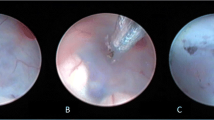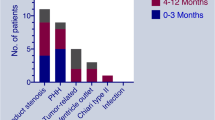Abstract
Objective
Patient’s age and etiology of hydrocephalus are the most important factors influencing the success rate of endoscopic third ventriculostomy (ETV). Failure rates are reported to be particularly high in the first year of age. On the basis of our own data and a metaanalysis of the literature, we try to further define the impact of age on ETV success in infants younger than 1 year.
Materials and methods
Only patients with a minimum follow-up of 12 months were considered. Between October 1994 and July 2004, 28 patients younger than 1 year underwent ETV in our institution. Age ranged from 8 to 311 days (median 96). The etiology of hydrocephalus was aqueductal stenosis (AS) in all patients (idiopathic in 13, posthemorrhagic in three, postmeningitic in four, and related to CNS or vascular malformation or to tumor in eight). ETV failure was defined as subsequent need for shunt implantation. The metaanalysis of the literature took into account reported series on ETV in infants with detailed data on age and etiology in every single patient.
Results
In our own patients, ETV was successful in 13 patients and eventually failed in 15. In the ETV success group, the median age was 200 days and the mean age was 176 days (range 13–311 days). In the ETV failure group, the ages were 105 days (median), 117 days (mean), and 8–299 days (range). The differences were not statistically significant. Age distributions in both outcome groups showed a tendency of failures to occur more frequently in the first 2–4 months of life. The separate analysis of patients with idiopathic AS yielded similar figures and distributions. The data from the metaanalysis of the literature corresponded to our own results.
Conclusion
There is a clear impact of age on ETV failure rate even when excluding etiological factors. The probability of ETV success gradually increases during the first months of life. The consequence of these findings for decision-making as well as parental counseling is to try to weigh the age of the infant and its estimated impact on ETV success with other factors guiding the decision to perform ETV or shunt in the treatment of obstructive hydrocephalus.




Similar content being viewed by others
References
Abdullah J, Ariff AR, Ghazaime G, Naing NN (2001) Stereotactic neuroendoscopic management of hydrocephalus: a three-year follow-up and analysis of Malaysian children with aqueduct stenosis. Stereotact Funct Neurosurg 76:175–180
Beems T, Grotenhuis JA (2002) Is the success rate of endoscopic third ventriculostomy age-dependent? An analysis of the results of endoscopic third ventriculostomy in young children. Childs Nerv Syst 18:605–608
Boschert J, Neff W, Schaible T (2002) Endoskopische Ventrikulozisternostomie im frühen Kindesalter. Praktische Pädiatrie 8:232–240
Brockmeyer D, Abtin K, Carey L, Walker ML (1998) Endoscopic third ventriculostomy: an outcome analysis. Pediatr Neurosurg 28:235–240
Buxton N, Macarthur D, Mallucci C, Punt J, Vloeberghs M (1998a) Neuroendoscopic third ventriculostomy in patients less than 1 year old. Pediatr Neurosurg 29:73–76
Buxton N, Macarthur D, Mallucci C, Punt J, Vloeberghs M (1998b) Neuroendoscopy in the premature population. Childs Nerv Syst 14:649–652
Cinalli G (1999) Alternatives to shunting. Childs Nerv Syst 15:718–731
Cinalli G, Sainte-Rose C, Chumas P, Zerah M, Brunelle F, Lot G, Pierre-Kahn A, Renier D (1999) Failure of third ventriculostomy in the treatment of aqueductal stenosis in children. J Neurosurg 90:448–454
Elbabaa SK, Steinmetz M, Ross J, Moon D, Luciano MG (2001) Endoscopic third ventriculostomy for obstructive hydrocephalus in the pediatric population: evaluation of outcome. Eur J Pediatr Surg 11(Suppl 1):S52–S54
Fritsch MJ, Kehler U, Joedicke A, Boschert J, Wagner W (2005) Endoscopic third ventriculostomy (ETV) in infants under one year of age: a German multicenter study. Childs Nerv Syst 21:495–496 (Abstract)
Fritsch MJ, Mehdorn M (2002) Endoscopic intraventricular surgery for treatment of hydrocephalus and loculated CSF space in children less than one year of age. Pediatr Neurosurg 36:183–188
Gorayeb RP, Cavalheiro S, Zymberg ST (2004) Endoscopic third ventriculostomy in children younger than 1 year of age. J Neurosurg Pediatrics 100(Suppl 5):427–429
Goumnerova LC, Frim DM (1997) Treatment of hydrocephalus with third ventriculocisternostomy: outcome and CSF flow patterns. Pediatr Neurosurg 27:149–152
Grunert P, Charalampaki P, Hopf N, Filippi R (2003) The role of third ventriculostomy in the management of obstructive hydrocephalus. Minim Invasive Neurosurg 46:16–21
Hellwig D, Grotenhuis JA, Tirakotai W, Riegel T, Schulte DM, Bauer BL, Bertalanffy H (2005) Endoscopic third ventriculostomy for obstructive hydrocephalus. Neurosurg Rev 28:1–34
Hopf NJ, Grunert P, Fries G, Resch KD, Perneczky A (1999) Endoscopic third ventriculostomy: outcome analysis of 100 consecutive procedures. Neurosurgery 44:795–804
Husain M, Jha D, Vatsal DK, Thaman D, Gupta A, Husain N, Gupta RK (2003) Neuro-endoscopic surgery—experience and outcome analysis of 102 consecutive procedures in a busy neurosurgical centre of India. Acta Neurochir (Wien) 145:369–375
Javadpour M, Mallucci C, Brodbelt A, Golash A, May P (2001) The impact of endoscopic third ventriculostomy on the management of newly diagnosed hydrocephalus in infants. Pediatr Neurosurg 35:188–194
Jones R, Kadrian D, van Gelder J, Florida D, Stening W, Kwok B, Teo C, Vonau M (2005) Endoscopic third ventriculostomy—our experience in Sidney. Childs Nerv Syst 21:507 (Abstract)
Jones RF, Kwok BC, Stening WA, Vonau M (1994a) The current status of endoscopic third ventriculostomy in the management of non-communicating hydrocephalus. Minim Invasive Neurosurg 37:28–36
Jones RF, Kwok BC, Stening WA, Vonau M (1994b) Neuroendoscopic third ventriculostomy. A practical alternative to extracranial shunts in non-communicating hydrocephalus. Acta Neurochir (Wien) 61 Suppl:79–83
Jones RF, Kwok BC, Stening WA, Vonau M (1996) Third ventriculostomy for hydrocephalus associated with spinal dysraphism: indications and contraindications. Eur J Pediatr Surg 6(Suppl 1):5–6
Jones RF, Stening WA, Brydon M (1990) Endoscopic third ventriculostomy. Neurosurgery 26:86–91
Kamikawa S, Inui A, Kobayashi N, Kuwamura K, Kasuga M, Yamadori T, Tamaki N (2001) Endoscopic treatment of hydrocephalus in children: a controlled study using newly developed Yamadori-type ventriculoscopes. Minim Invasive Neurosurg 44:25–30
Kehler U, Gliemroth J (2002) Endoskopische Ventrikulozisternostomie bei Säuglingen und Kleinkindern – eine Alternative zum Shunt? Praktische Pädiatrie 8:244–247
Kim SK, Wang KC, Cho BK (2000) Surgical outcome of pediatric hydrocephalus treated by endoscopic III ventriculostomy: prognostic factors and interpretation of postoperative neuroimaging. Childs Nerv Syst 16:161–169
Koch D, Wagner W (2004) Endoscopic third ventriculostomy in infants of less than 1 year of age: which factors influence the outcome? Childs Nerv Syst 20:405–411
Kunz U, Goldmann A, Bader C, Waldbaur H, Oldenkott P (1994) Endoscopic fenestration of the 3rd ventricular floor in aqueductal stenosis. Minim Invasive Neurosurg 37:42–47
Macarthur DC, Buxton N, Vloeberghs M, Punt J (2001) The effectiveness of neuroendoscopic interventions in children with brain tumours. Childs Nerv Syst 17:589–594
Moorthy RK, Rajshekhar V (2002) Management of hydrocephalus associated with occipital encephalocoele using endoscopic third ventriculostomy: report of two cases. Surg Neurol 57:351–355
Murshid WR (2000) Endoscopic third ventriculostomy: towards more indications for the treatment of non-communicating hydrocephalus. Minim Invasive Neurosurg 43:75–82
Oi S, Hamada H, Nonaka Y, Kusaka Y, Samii A, Samii M (2004) Proposal of a “theory in CSF dynamics”: a significant factor affecting the failure of neuroendoscopic ventriculostomy in treatment for hydrocephalus. Childs Nerv Syst 20:662 (Abstract)
Sainte-Rose C (1992) Third ventriculostomy. In: Manwaring KH, Crone KR (eds) Neuroendoscopy, vol 1. Mary Ann Liebert, New York, pp 47–62
Scarrow AM, Levy EI, Pascucci L, Albright AL (2000) Outcome analysis of endoscopic III ventriculostomy. Childs Nerv Syst 16:442–445
Sgouros S, Kulkharni A, Constantini S (2005) The International Infant Hydrocephalus Study: concept and rationale. Childs Nerv Syst 22:338–345
Singh D, Gupta V, Goyal A, Singh H, Sinha S, Singh AK, Kumar S (2003) Endoscopic third ventriculostomy in obstructed hydrocephalus. Neurol India 51:39–42
Siomin V, Cinalli G, Grotenhuis A, Golash A, Oi S, Kothbauer K, Weiner H, Roth J, Beni-Adani L, Pierre-Kahn A, Takahashi Y, Mallucci C, Abbott R, Wisoff J, Constantini S (2002) Endoscopic third ventriculostomy in patients with cerebrospinal fluid infection and/or hemorrhage. J Neurosurg 97:519–524
Teo C (1998) Third ventriculostomy in the treatment of hydrocephalus: experience with more than 120 cases. In: Hellwig D, Bauer BL (eds) Minimally invasive techniques for neurosurgery. Springer, Berlin Heidelberg New York, pp 73–76
Teo C, Jones R (1996) Management of hydrocephalus by endoscopic third ventriculostomy in patients with myelomeningocele. Pediatr Neurosurg 25:57–63
Valenzuela S, Trellez A (1999) Pediatric neuroendoscopy in Chile. Analysis of the first 100 cases. Childs Nerv Syst 15:457–460
Wagner W, Koch D (2005) Mechanisms of failure after endoscopic third ventriculostomy in young infants. J Neurosurg 103(Suppl 1):43–49
Warf BC (2005) Hydrocephalus in Uganda: the predominance of infectious origins and primary management with endoscopic third ventriculostomy. J Neurosurg 102(Suppl 1):1–15
Author information
Authors and Affiliations
Corresponding author
Rights and permissions
About this article
Cite this article
Koch-Wiewrodt, D., Wagner, W. Success and failure of endoscopic third ventriculostomy in young infants: are there different age distributions?. Childs Nerv Syst 22, 1537–1541 (2006). https://doi.org/10.1007/s00381-006-0191-7
Received:
Published:
Issue Date:
DOI: https://doi.org/10.1007/s00381-006-0191-7




